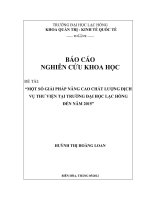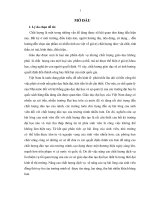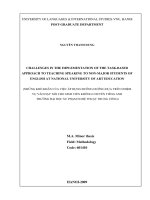Khảo sát quan điểm của sinh viên không chuyên tiếng Anh về các chiến lược cụ thể để cải thiện khả năng phát âm âm cuối tại trường Đại học Lạc Hồng
Bạn đang xem bản rút gọn của tài liệu. Xem và tải ngay bản đầy đủ của tài liệu tại đây (680.01 KB, 4 trang )
JSLHU
JOURNAL
OFSCIENCE
SCIENCE
JOURNAL OF
www.jslhu.edu.vn
Tạp chí Khoa học Lạc Hồng 2020, 11, 030-033
Tạp chí Khoa học Lạc Hồng 20xx, x, xx-zz
JSLHU
OF
LAC HONG
UNIVERSITY
OF LAC
HONG UNIVERSITY
A SURVEY INTO NON-ENGLISH MAJORED STUDENTS’
PERSPECTIVES ON SPECIFIC STRATEGIES TO IMPROVE FINAL
SOUND PRONUNCIATION AT LAC HONG UNIVERSITY
KHẢO SÁT QUAN ĐIỂM CỦA SINH VIÊN KHÔNG CHUYÊN TIẾNG
ANH VỀ CÁC CHIẾN LƯỢC CỤ THỂ ĐỂ CẢI THIỆN KHẢ NĂNG
PHÁT ÂM ÂM CUỐI TẠI TRƯỜNG ĐẠI HỌC LẠC HỒNG
2,b*
Bui Minh Huong1a
3
2 and Hoang Vinh Loc
Bui Minh Huong,
Vinh
Loc, Nguyen
Bich Huong
FacultyHoang
of English
Language,
Lac HongThi
University,
Vietnam
1
1
Faculty of English Language, Lac Hong University, Vietnam
a
b
,
*
, ,
1,2,32
ABSTRACT. The purposes of this small-scale survey were to elucidate opinions of and strategies towards strengthening the
final sound pronunciation of non-English majored students at Lac Hong University. The subjects of this study were 80
sophomores of four different faculties and had been learning English for at least six years. A questionnaire and structured
interviews were utilized to gather research data. The results showed that the participants were aware of the significance and
difficulties of final sound pronunciation in learning English. Moreover, singing along English songs, watching English
channels or movies, joining e-learning courses and imitating English accent in TV programs or movies were the strategies
which the students believed to be the most efficient in advancing their final sound pronunciation. This survey made a
substantial contribution to raising the consciousness of learners in English pronunciation learning and affording perceptive
insights into teaching English pronunciation.
KEYWORDS. final sound pronunciation, pronunciation strategies, beliefs
TÓM TẮT. Mục đích của bài khảo sát quy mơ nhỏ này là làm sáng tỏ quan điểm và chiến lược để tăng cường kỹ năng phát
âm âm cuối của sinh viên không chuyên tiếng Anh tại trường Đại học Lạc Hồng. Đối tượng của bài nghiên cứu gồm 80 sinh
viên năm hai của 4 khoa khác nhau và đã học tiếng Anh ít nhất 6 năm. Bảng câu hỏi khảo sát và phỏng vấn trực tiếp đã được
sử dụng để thu thập dữ liệu nghiên cứu. Kết quả khảo sát cho thấy những người tham gia đã nhận thức được tầm quan trọng
và khó khăn của việc phát âm âm cuối trong việc học tiếng Anh. Bên cạnh đó, những chiến lược mà đối tượng nghiên cứu
tin là có hiệu quả nhất trong việc nâng cao kỹ năng phát âm âm cuối bao gồm: hát theo các bài hát tiếng Anh, xem các kênh
hoặc phim tiếng Anh, tham gia các khóa học trực tuyến và bắt chước theo giọng Anh trên các chương trình truyền hình hoặc
phim ảnh. Khảo sát này đã đóng góp đáng kể vào việc nâng cao ý thức của người học trong phát âm tiếng Anh và mang lại
cho giáo viên những chiến lược hiệu quả và hiểu biết sâu sắc hơn trong việc dạy phát âm tiếng Anh.
TỪ KHOÁ. phát âm âm cuối, chiến lược phát âm, nhận thức
1. INTRODUCTION
Learning a foreign language nowadays tends to shift its
focus from structure competence to communicative
competence, teaching pronunciation is drawing the attention
of teachers, educators and educational researchers.
Roberson [11] supposes that ‘without adequate
pronunciation skills, the learners’ ability to communicate is
severely limited’. Furthermore, Gilakjani [6] stresses that
comprehensible pronunciation is a crucial constituent of
communicative competence. Teachers should, therefore,
come up with strategies both practical and feasible to meet
learners’ demands on effective communication.
In Vietnamese context, teaching and learning
pronunciation is an urgent and significant problem because
of the existence of some common pronunciation problems of
Vietnamese learners of English such as sound omission,
sound mispronunciation, and sound redundancy (Tam [12]).
According to the findings of Tam’s study, the most common
errors were the omission of final sounds. The main reason
for this problem is that in Vietnamese, speakers do not
pronounce final sounds and cluster of consonants. In fact,
this problem of pronunciation results in obstacles for
improvement of not only speaking but also English listening
skills. A prominent hindrance is that learners’ inaccurate
30
Tạp chí Khoa học Lạc Hồng
pronunciation makes it difficult for their listeners to
comprehend (Ur [14]) or some learners tend to overpronounce final sounds by adding /s/ or /z/ at the end of any
word, commonly leading to communication breakdown
(Tam [12]). Another difficulty results from the fact that when
speaking, native or competent speakers of English usually
employ such connected speech as ‘What do you think of
soap opera?’.
In fact, when teaching and assessing students in oral
examinations, the researchers found that one of the most
common pronunciation errors students made was the lack of
final sound pronunciation. Despite the urgency and
importance of the final pronunciation problems in English of
Vietnamese students in general and Lac Hong students in
particular, few studies have been conducted to offer
strategies to improve and raise learners’ awareness of the
final sound pronunciation. Consequently, this survey was
carried out to answer the following two questions:
Are non-English majored students at Lac Hong
University aware of the final sounds when speaking?
Received: June, 22nd 2020
Accepted: August 18th 2020
*Corresponding Author
Email:
Bui Minh Huong & Hoang Vinh Loc
What are beliefs and strategies that non-English majored
students at Lac Hong University draw on to improve
their final sound pronunciation?
2. CONTENT
2.1 Research Methods
Participants
Participants aged between 18 and 25 were randomly
selected among 80 sophomores majoring in Information
Technology, Civil Engineering, Pharmacy, Finance and
Banking, and Food Engineering at Lac Hong University. Of
the questionnaire respondents, eight interviewees consented
to be interviewed.
Data collection instruments
The data was collected through both questionnaires and
structured interviews within May 2020. According to
McDonough & McDonough [8], questionnaires for
educational and ELT researches seemed to be very popular
and advantageous. In addition, Chamot [4] asserts that “the
most frequently used method for identifying students’
learning strategies is through questionnaires”. Therefore, a
mixture of closed-response questions and open-response
questions was employed in designing questionnaire to make
good use of the advantages and limit the disadvantages of
questionnaire (Brown [3]). The 14-item questionnaire aimed
at exploring students’ awareness, beliefs and their strategies
to improve their final sound pronunciation in English
learning. Specific strategies to improve final sound
pronunciation mentioned in the questionnaire were based on
both researchers’ teaching and learning English experience
and experts’ empirical
studies in the related field.
Particularly, according to Tse [13], songs are not only helpful
aural materials, but also the most unwinding language
learning strategy considered by English learners.
Additionally, in the words of Almurashi [1], authentic
English videos, especially those on YouTube website can
effectively reduce students’ obstacles in understanding reallife English. Moreover, exploiting English movies in
teaching is an undeniably popular measure to foster learners’
motivation in learning and improve their communication
competence (Li [7]).
Questionnaires and interview questions were piloted
before being used to increase objectiveness and reduce
potential problems (Nunan [9]). 20 out of 80 participants
joined the pilot survey and discussed questions in the
questionnaire and interview. Some questions were revised
for appropriateness after analyzing responses and feedback
from the pilot questionnaire and interviews.
Data collection procedures
First of all, the purpose of the survey, confidentiality and
anonymity were stressed before distributing questionnaires
and conducting interviews. The questionnaires were handed
out to the participants along with clear elaboration on each
item.
Next, the interviews were employed to gain in-depth
information and to better explain and validate the results of
questionnaires. Importantly, the face-to-face interviews were
recorded with the interviewees’ permission. The interviews
were conducted in English and lasted about eighty minutes
(ten minutes for each interview).
The calculated data were displayed as percentages, charts
and tables to report in results and discussion. For openresponse questions of both questionnaires and interviews,
typical answers of each question were transcribed and typed.
All data were described and analyzed in categories of
awareness, beliefs and strategies in improving final sound
pronunciation.
2.2 Findings and Discussion
2.2.1 Learners’ Perspectives about the Importance of
Final Sound Pronunciation
It was proved statistically that almost all of the participants
were fully aware of the importance of pronouncing final
sounds, as can be seen in Figure 1. Specifically, the
adjectives “useful”, “interesting”, “necessary”, “important”
were found frequently in interviews to express participants’
own ideas on final sounds in English learning.
Figure 1. Learners’ perspectives about the importance of final
sound pronunciation
Although a majority of learners were acutely conscious of
the significance of final sound pronunciation and had been
learning English for at least six years, they still encountered
a myriad of difficulties in final sound pronunciation. One of
the most noticeable problems they faced was not knowing
how to correctly pronounce some final sounds. Transcripts
from the interviews proved that most of the interviewees
mispronounced final sounds. For instance, they often
pronounced /s/ instead of /iz/ for plural nouns ending in ‘-s/es’ or /id/ for all ‘-ed’ final sounds. Moreover, when asked
about pronunciation practice in class, 90% of the respondents
asserted that their teachers did give them activities related to
pronunciation. The final sound pronunciation, however, was
not emphasized in those activities. Therefore, question 13 in
the questionnaire revealed that learners expected their
teachers to give them more activities to practice and then
evaluate their progress.
2.2.2 Learners’ attitudes
pronunciation courses
towards
free
online
In addition, almost all of the participants stated that they
were interested in improving their final sound pronunciation,
and they could spend from 2 to 4 hours a week to practise
pronouncing final sounds. On top of that, it was immensely
encouraging to learn that about 71 respondents (89%) would
like to actively take part in free online courses to improve
their final sound pronunciation. (Figure 2). This perspective
is confirmed in the study by Chavangklang [5] who
concluded that after using pronunciation E-learning package,
learners’ final consonant pronunciation skills were greatly
improved.
Tạp chí Khoa học Lạc Hồng
31
Enhancing final sound pronunciation of non-English majored students through a strategic approach: A case study at LHU
Number of respondents
80
sounds will aid students to overcome the pronunciation
obstacles in English learning. Based on the effective
strategies evaluated by the participants in this research,
another suggestion is that teachers should give students
inspiring and adequate instructed activities focusing on final
sound pronunciation, including singing along English songs
and watching and imitating standard English accents in TV
programs and movies. Additionally, thanks to the
development of information technology, teachers can fully
exploit the benefits of online courses to help their students
autonomously enhance their pronunciation capability. Last
but not least, improving final sound pronunciation is not
merely the responsiblity of teachers, students themselves
have to practice and adopt appropriate and effective
strategies in their English learning.
71
60
40
20
9
0
Yes
No
Figure 2. Learners’ attitudes towards free online
pronunciation courses
3. CONCLUSION
Strategies
2.2.3 Learners’ Strategies to Improve Final Sound
Pronunciation
Join E-learning/online courses
Sing along English songs
Practice the final sounds as it…
Ask your friends to remind you of…
Practice with your English teacher…
Imitate English voice in radio/TV…
Make friends with native English…
Travel to English speaking countries
Read aloud and along the…
Record your own voice in English,…
Watch English channels or movies…
0
23,75
55
7,5
3,75
5
20
22,5
12,5
16,25
16,25
43,75
20
40
60
Percentage
Figure 3. The most effective learning strategies
It could be seen in Figure 3 that the strategies respondents
believed to be the most effective to improve their final sound
pronunciation consisted of singing along English songs
(55%), watching English channels or movies to practice
listening to final sounds through authentic materials
(43.75%), joining e-learning courses (23.75%) and imitating
English accent in TV programs or movies (22.5%). The
interview questions 7 and 8 then served to verify the most
helpful strategies these learners used to improve their final
sound pronunciation. Particularly, two interviewees who
were very fluent in speaking English and good at
pronouncing final sounds claimed that their fluency came
from “practicing listening and singing English songs a lot”
and “my sister is an English teacher. She always corrects my
final sound pronunciation.” Actually, a majority of
participants in Tse’s research [13] also believe that songs are
both entertaining and helpful.
Coincidentally, the most common approach they would
like to use to evaluate their pronunciation improvement, also
their expectation of their teachers, was asking their teachers
to correct their final sound pronunciation and include
pronouncing final sounds in the marking criteria in oral
examinations to force them always think about final sounds.
The findings briefly discussed above generated some
suggestions for final sound problems. The first
recommendation is that teachers need to give students
activities or some necessary instructions of final sounds
during class time to help them pronounce final sounds
correctly and naturally. In fact, profound knowledge of final
32
Tạp chí Khoa học Lạc Hồng
The survey aimed at investigating whether non-English
majored students at Lac Hong University were aware of the
importance of and difficulties in pronouncing English final
sounds. More importantly, some learning strategies which
the students believed to be efficient were also identified and
clarified.
The researchers made use of the questionnaire and
structured interviews conducted among 80 second-year
students from four different faculties at Lac Hong University
to gather research data.
The survey findings disclosed that the participants were
well aware of final sounds when speaking English because
they believed that final sounds play a pivotal role in English
listening and speaking skills. The findings indicated that
there were four strategies the students claimed to be the most
useful for progressing in their final sound pronunciation.
In the light of the findings, final sound instructions and
activities should be constantly stressed in English teaching
practice. Furthermore, the strategies that the participants
chosen triggered some ideas of devising online activities
integrating final sound practice with English songs and
movies. Though modest, it is hoped that the survey may
contribute to raising the awareness of learners in their
pronunciation learning and helping some teachers have a
closer look at learners’ beliefs and strategies to teach
pronunciation more successfully.
However, this survey exposes some limitations about the
small size of participants and the methods employed to
conduct the research. Therefore, future researches related to
final-sound pronunciation improvement should be
conducted in a wider range of contexts and participants; and
employ more methods to increase validity and reliability of
strategy research such as experiment, ‘randomized
controlled trial’ (Andrews [2]) to test the effectiveness of
suggested strategies.
4.
REFERENCES
[1] Almurashi, W. A. The effective use of YouTube videos for
teaching English language in classrooms as supplementary
material at Taibah University in Alula. International Journal
of English Language and Linguistics Research, 2016, 4(3),
32-47.
[2] Andrews, R. Research questions. London: Continuum, 2003.
[3] Brown, J. D. Using surveys in language programs.
Cambridge University Press, 2001.
[4] Chamot, A. U. Language learning strategy instruction:
Current issues and research. Annual review of applied
linguistics, 2005, 25, 112-130.
Bui Minh Huong & Hoang Vinh Loc
[5] Chavangklang, P. Enhancing final consonant pronunciation
skill of the first year students at Nakhonratchasima Rajabhat
University through E-learning. Procedia-Social and
Behavioral Sciences, 2013, 91, 437-443.
[6] Gilakjani, A. P. A study of factors affecting EFL learners'
English pronunciation learning and the strategies for
instruction. International Journal of Humanities and Social
Science, 2012, 2(3), 119-128.
[7] Li, X., & Wang, P. A research on using English movies to
improve Chinese college students' oral English. Theory and
Practice in Language Studies, 2015, 5(5), 1096-1100.
[8] McDonough, J., & McDonough, S. Research methods for
English language teachers. Routledge, 2014.
[9] Nunan, D. Research methods in language learning.
Cambridge: Cambridge University Press, 1992.
[10] Pennington, M. Recent research in L2 phonology:
Implications for practice. Pronunciation pedagogy and
theory. New views, new directions, 1994, 92-108.
[11] Roberson. Teaching English Pronunciation Skills to the Asian
Learner. A Cultural Complexity or Subsumed Piece of Cake?
Asian EFL Journal, 2003, 5(1), 1-26.
[12] Tam, H. C. Common pronunciation problems of Vietnamese
learners of English. VNU Journal of Foreign Studies, 2005,
21. Retrieved from
/>[13] Tse, A. Y. H. Malaysian teachers' perspectives on using songs
in English language teaching. International Journal of Social
Science and Humanity, 2015, 5(1), 87.
[14] Ur, P. A Course in Language Teaching: Practice and Theory.
Cambridge: Cambridge University Press, 1996.
Tạp chí Khoa học Lạc Hồng
33









